
The family Dipluridae, known as curtain-web spiders are a group of spiders in the infraorder Mygalomorphae, that have two pairs of booklungs, and chelicerae (fangs) that move up and down in a stabbing motion. A number of genera, including that of the Sydney funnel-web spider (Atrax), used to be classified in this family but have now been moved to Atracidae.
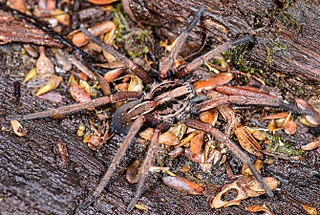
Miturgidae is a family of araneomorph spiders that includes nearly 170 species in 29 genera worldwide. First described by Eugène Simon in 1886, it has been substantially revised, and includes the previous family Zoridae as a synonym, and excludes the family Xenoctenidae. Several genera have also been removed, such as the large genus Cheiracanthium, which was transferred to the Cheiracanthiidae.

Hexathelidae is a family of mygalomorph spiders. It is one of a number of families and genera of spiders known as funnel-web spiders. In 2018, the family was substantially reduced in size by genera being moved to three separate families: Atracidae, Macrothelidae and Porrhothelidae. Atracidae includes the most venomous species formerly placed in Hexathelidae.

Zoropsidae, also known as false wolf spiders for their physical similarity to wolf spiders, is a family of cribellate araneomorph spiders first described by Philipp Bertkau in 1882. They can be distinguished from wolf spiders by their two rows of eyes that are more equal in size than those of Lycosidae.
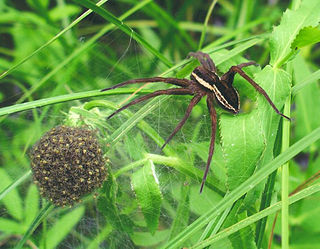
Dolomedes is a genus of large spiders of the family Pisauridae. They are also known as fishing spiders, raft spiders, dock spiders or wharf spiders. Almost all Dolomedes species are semiaquatic, with the exception of the tree-dwelling D. albineus of the southeastern United States. Many species have a striking pale stripe down each side of the body.
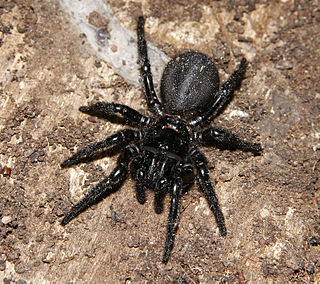
Hadronyche is a genus of venomous Australian funnel-web spiders that was first described by L. Koch in 1873. Originally placed with the curtain web spiders, it was moved to the Hexathelidae in 1980, then to the Atracidae in 2018.

Selenocosmia crassipes, synonym Phlogius crassipes, also known as the "Queensland whistling tarantula", "barking spider" or "bird-eating tarantula" is a species of tarantula native to the east coast of Queensland, Australia. The name "whistling tarantula" comes from its ability to produce a hissing noise when provoked, a trait it shares with other Australian theraphosids. This hissing is produced by the spider stridulating a patch of setae associated with its chelicerae. It has also been called the "eastern tarantula". The species name crassipes is Latin for "fat leg" referring to the relatively fat front legs.
Nihoa is a genus of South Pacific brushed trapdoor spiders first described by Tracey Churchill & Robert Raven in 1992. It is named after the island Nihoa, where the type species is endemic.

Idiopidae, also known as armored or spiny trapdoor spiders, is a family of mygalomorph spiders first described by Eugène Simon in 1889.
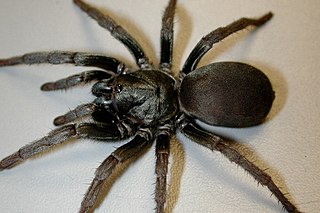
Nemesiidae, also known as funnel-web trapdoor spiders, is a family of mygalomorph spiders first described by Eugène Simon in 1889, and raised to family status in 1985. Before becoming its own family, it was considered part of "Dipluridae".

Barychelidae, also known as brushed trapdoor spiders, is a spider family with about 300 species in 42 genera.
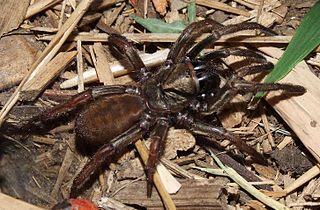
Arbanitis is a genus of Australian armoured trapdoor spiders that was first described by Ludwig Carl Christian Koch in 1874.

Sidymella is a genus of spider in the family Thomisidae, found in South America, Australia and New Zealand. It was originally named Sidyma, but this was later found to have been used already for a genus of moths.
Ozicrypta is a genus of Australian brushed trapdoor spiders first described by Robert Raven in 1994.
Trittame is a genus of brushed trapdoor spiders first described by German arachnologist Ludwig Carl Christian Koch in 1874. It is endemic to Australia.
Australomisidia is a genus of spiders in the family Thomisidae. It was first described in 2014 by Szymkowiak. As of 2017, it contains 8 species, all from Australia.
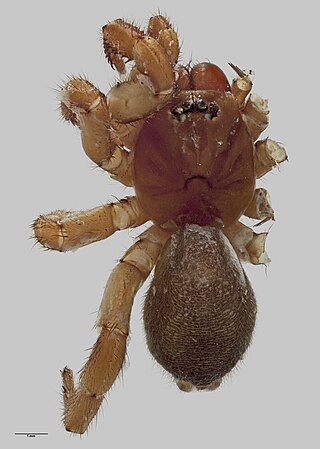
Migas is a genus of spiders in the family Migidae. Most species are found only in New Zealand.
Idioctis xmas is a species of mygalomorph spider in the Barychelidae family. It is endemic to Australia. It was described in 1988 by Australian arachnologist Robert Raven. The specific epithet xmas is an abbreviation for ‘Christmas’, with reference to the type locality.
Idioctis yerlata, also known as the intertidal trapdoor spider, is a species of mygalomorph spider in the Barychelidae family. It is endemic to Australia. It was described in 1992 by Australian arachnologists Tracey Churchill and Robert Raven. The specific epithet yerlata is an Aboriginal term for ‘oyster’, for the perceived similarity to the door of the spider's burrow.












